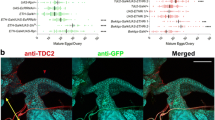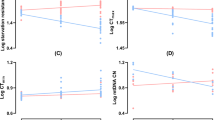Abstract
The effect of heat stress (38°C) on the content of octopamine (OA) and 20-hydroxyecdysone (20HE) was studied under normal and stressful conditions in adult flies of Drosophila virilislines contrasting in the level of the juvenile hormone (JH). The wild-type flies (line 101) exhibited a pronounced sex dimorphism for the content of both OA and 20HE, which was substantially lower in this line than in flies of the mutant line 147. The level of both hormones increased in flies of line 101 exposed to heat stress, whereas it remained unchanged in flies of line 147 under the same conditions. The effect of heat stress on the level of JH metabolism and fertility was also studied in D. melanogasterwild-type lines and lines carrying mutations in genes responsible for OA and DA syntheses. In octopamineless females of the Tβh nM18line and in females of the Steline characterized by a doubled content of DA, JH degradation differed from normal: it was increased in both young and mature Tβh nM18females, while decreased in young and increased in mature Steflies. Fertility was substantially lower in the Stethan in the wild-type line. Flies of all of the D. melanogasterlines produced a stress response; however, in mutant lines, both fertility and stress reactivity of the systems controlling JH metabolism differed significantly from that of the wild-type lines. The role of JH, 20HE, OA, and DA interaction in regulation of Drosophilareproduction under stressful conditions is discussed.
Similar content being viewed by others
REFERENCES
Postlethwait, J.H. and Shirk, P.D., Genetics and Endocrine Regulation of Vitellogenesis in Drosophila, Am. Zool., 1981, vol. 21, pp. 687-700.
Koerre, J.K., Fuchs, M., Chen, T.T., et al., The Role of Juvenile Hormone in Reproduction, in Comprehensive Insect Physiology, Biochemistry and Pharmacology, New York: Pergamon, 1985, vol. 8, pp. 165-203.
Bownes, M., Ronaldson, E., Mauchline, D., and Martinez, A., Regulation of Vitellogenesis in Drosophila, Int. J. Insect Morphol. Embryol., 1993, vol. 22, pp. 349-367.
Jowett, T. and Postlethwait, J., Hormonal Regulation of Synthesis of Yolk Proteins and a Larvae Serum Protein (LSP) in Drosophila, Nature, 1981, vol. 292, pp. 633-635.
An, W. and Wensink, P.C., Integrating Sex-and Tissue-Specific Regulation within a Single Drosophila Enhancer, Genes Dev., 1995, vol. 9, pp. 256-266.
Soller, M., Bownes, M., and Kubli, E., Control of Oocyte Maturation in Sexually Mature Drosophila Females, Dev. Biol., 1999, vol. 208, pp. 337-351.
Redfern, C.P.F. and Bownes, M., Pleiotropic Effects of the ecdysonless-1 Mutation of Drosophila melanogaster, Mol. Gen. Genet., 1983, vol. 189, pp. 432-440.
Bownes, M. and Reid, G., The Role of the Ovary and Nutritional Signals in the Regulation of Fat Body Yolk Protein Gene Expression in Drosophila melanogaster, J. Insect Physiol., 1990, vol. 36, pp. 471-480.
Richard, D.S., Watkins, N.L., Serafin, R.B., and Gilbert, L.I., Ecdysteroids Regulate Yolk Protein Uptake by Drosophila melanoganter Oocytes, J. Insect Physiol., 1998, vol. 44, pp. 637-644.
Thompson, C.S., Yagi, K.J., Chen, Z.F., and Tobe, S.S., The Effects of Octopamine on Juvenile Hormone Biosynthesis, Electrophysiology, and cAMP Content of the Corpora Allata of the Cockroach Diploptera punctata, J. Comp. Physiol. B, 1990, vol. 160, pp. 241-249.
Lafon-Cazal, M. and Baehr, J.C., Octopaminergic Control of Corpora Allata Activity in an Insect, Experentia, 1988, vol. 44, pp. 895-896.
Kaatz, H., Eichmuller, S., and Kreissl, S., Stimulatory Effect of Octopamine on Juvenile Hormone Biosynthesis in Honey Bees (Apis mellifera): Physiological and Immunocytochemical Evidence, J. Insect Physiol., 1994, vol. 40, pp. 856-872.
Rachinsky, A., Octopamine and Serotonin Influence on Corpora Allata Activity in Honey Bee (Apis mellifera) Larvae, J. Insect Physiol., 1994, vol. 40, pp. 549-554.
Pastor, D., Piulachs, M.D., Gassier, P., et al., In Vivo and In Vitro Study of the Action of Dopamine on Oocyte Growth and Juvenile Hormone Production in Blattella germanica, C.R. Acad. Sci. III, 1991, vol. 313, pp. 207-212.
Hirashima, A., Suetsugu, E., Hirokado, S., et al., Effect of Octopamine on the Activity of Juvenile-Hormone Esterase in the Silkworm Bombyx mori and the Red Flour Beetle Tribolium freemani, Gen. Comp. Endocrinol., 1999, vol. 116, pp. 373-381.
Rauschenbach, I.Yu., Lukashina, N.S., and Korochkin, L.I., Genetic of Esterases in Drosophila: VIII. The Gene Controlling the Activity of JH Esterase in D. virilis, Biochem. Genet., 1984, vol. 22, pp. 5-80.
Rauschenbach, I.Yu., Lukashina, N.S., Maksimovsky, L.F., and Korochkin, L.I., Stress-like Reaction of Drosophila to Adverse Environmental Factors, J. Comp. Physiol. B, 1987, vol. 157, pp. 519-531.
Rauschenbach, I.Yu., Serova, L.I., Timochina, I.S., et al., Analysis of Differences in Dopamine Content between Two Lines of Drosophila virilis in Response to Heat Stress, J. Insect Physiol., 1993, vol. 39, pp. 761-767.
Monastirioti, M., Linn, C.E., Jr., and White, K., Characterization of Drosophila Tyramine β-Hydroxylase Gene and Isolation of Mutant Flies Lacking Octopamine, J. Neurosci., 1996, vol. 16, pp. 3900-3911.
Hodgetts, R.B. and Konopka, R.J., Tyrosine and Catecholamine Metabolism in Wild-Type Drosophila melanogaster and a Mutant, ebony, J. Insect Physiol., 1973, vol. 19, pp. 1211-1220.
Walter, M.F., Zeineh, L.L., Black, B.C., et al., Catecholamine Metabolism and In Vitro Induction of Premature Cuticle Melanization in Wild-Type and Pigmentation Mutants of Drosophila melanogaster, Arch. Insect Biochem. Physiol., 1996, vol. 31, pp. 219-233.
Rauschenbach, I.Yu., Gruntenko, N.E., Khlebodarova, T.M., et al., The Role of the Degradation System of the Juvenile Hormone in the Reproduction of Drosophila under Stress, J. Insect Physiol., 1996, vol. 42, pp. 735-742.
Hammock, B.D. and Sparks, T.C., A Rapid Assay for Insect Juvenile Hormone Esterase Activity, Anal. Biochem., 1977, vol. 82, pp. 573-579.
Hirashima, A., Sukhanova, M.Jh., and Rauschenbach, I.Yu., Genetic Control of Biogenic Amine System in Drosophila under Normal and Stress Conditions, Biochem. Genet., 2000, vol. 38, pp. 167-180.
Chang, E.S. and O'Connor, J.D., Arthropod Molting Hormones, Methods of Hormone Radioimmunoassay, Jaffe, B.M. and Behrman, H.R., Eds., New York: Academic, 1979, 2nd ed., pp. 797-814.
Rauschenbach, I.Yu., Khlebodarova, T.M., Chentsova, N.A., et al., Metabolism of the Juvenile Hormone in Drosophila Adults under Normal Conditions and Heat Stress, J. Insect Physiol., 1995, vol. 41, pp. 179-189.
Gruntenko, N.E., Khlebodarova, T.M., Sukhanova, M.Jh., et al., Prolonged Negative Selection of Drosophila melanogaster for a Character of Adaptive Significance Disturbs Stress Reactivity, Insect Biochem. Mol. Biol., 1999, vol. 29, pp. 445-452.
Gruntenko, N.E., Monastirioti, M., Wilson, T.G., and Rauschenbach, I.Yu., Stress Reactivity and Juvenile Hormone Degradation in Drosophila melanogaster Strains Having Stress-Related Mutations, Insect Biochem. Mol. Biol., 2000, vol. 30, pp. 775-783.
Altaratz, M., Applebaum, Sh.W., Richard, D.S., et al., Regulation of Juvenile Hormone Synthesis in Wild-Type and Apterous Mutant Drosophila, Mol. Cell. Endocrinol., 1991, vol. 81, pp. 205-216.
Hammock, B.D., Regulation of Juvenile Hormone Titer: Degradation, Comprehensive Insect Physiology, Biochemistry and Pharmacology, Kerkut, G.A. and Gilbert, L.I., Eds., New York: Pergamon, 1985, vol. 7, pp. 431-472.
Khlebodarova, T.M., Gruntenko, N.E., Grenback, L.G., et al., A Comparative Analysis of Juvenile Hormone-Metabolizing Enzymes in Two Species of Drosophila during Development, Insect Biochem. Mol. Biol., 1996, vol. 26, pp. 829-835.
Gruntenko, N.E., Khlebodarova, T.M., Vasenkova, I.A., et al., Stress Reactivity of a Drosophila melanogaster Strain with Impaired Juvenile Hormone Action, J. Insect Physiol., vol. 46, pp. 451-456.
Harshman, L.G., Loeb, A.M., and Johnson, B.A., Ecdysteroid Titers in Mated and Unmated Drosophila melanogaster Females, J. Insect Physiol., 1999, vol. 45, pp. 571-577.
Author information
Authors and Affiliations
Rights and permissions
About this article
Cite this article
Rauschenbach, I.Y., Gruntenko, N.E., Chentsova, N.S. et al. Regulation of Reproductive Function in DrosophilaFemales Due to Hormonal Interaction Under Stress Is Genetically Determined. Russian Journal of Genetics 37, 1041–1048 (2001). https://doi.org/10.1023/A:1011961514711
Issue Date:
DOI: https://doi.org/10.1023/A:1011961514711




